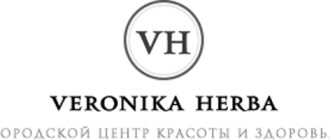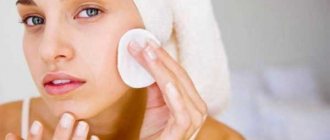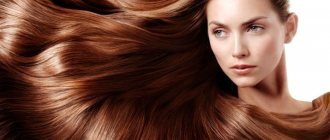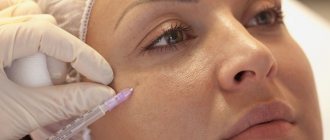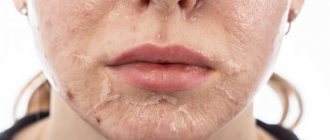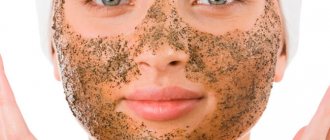Negative external factors, frequent stress, hormonal imbalances, insomnia, unbalanced diet or bad habits lead to a deterioration not only in the health of the epidermis, but also in its appearance.
Regular and properly selected cleansing will help get rid of rashes, restore healthy color to the skin, narrow pores, lighten age spots and restore elasticity.
It is best to choose a salon or home facial cleansing, taking into account the individual characteristics of the body, age and type of facial skin - this will help not only achieve the maximum positive result, but also avoid side effects.
Pros and cons of facial cleansing by a cosmetologist
Professional facial cleansing is a procedure that allows you to get rid of comedones, rashes and other minor imperfections. This is an effective method that solves many skin problems and significantly improves appearance.
The advantages of cleaning in cosmetology include the following factors:
- Cleansing. Any type of cleansing allows you to cope with skin contaminants: remove dirt, sebaceous plugs, bacteria from the pores.
- Improved complexion. Cleansing away dead cells, sebum and dirt gives the skin a pleasant, healthy glow.
- Regulating sebum secretion. Regular cleansing allows you to cope with increased sebum production and get rid of greasy shine. Also, some types of procedures help fight excessive dryness and flaking.
- Getting rid of unevenness, increasing tone. Due to the increased blood flow, metabolism in cells is normalized and elasticity returns. Wrinkles, potholes, and small scars disappear. The texture becomes soft and smooth.
Among the disadvantages of cleansing the skin in the salon are the following:
- Lack of result. The effectiveness of the procedure depends on the indications and the type of skin. If the type of procedure was chosen incorrectly, the client may not receive the necessary effect.
- Regularity of sessions. To maintain good results, the procedure must be performed constantly, at least once a month. For many women, this seems costly: it takes a lot of time and money.
- Possible discomfort. Some types of cleansing are accompanied by pain, redness, and allergies. In addition, the skin will require a rehabilitation period.
By choosing the right type of cleansing to suit your face type and needs, the downsides of the procedure can be minimized.
Are there any side effects?
If you ignore contraindications and post-procedure recommendations, and also contact specialists without medical education, skin cleansing in a salon can cause many side effects.
Common negative reactions include the following:
- Redness. Appears due to injury by mechanical or chemical action. After the session, at least 1-2 days should pass for the redness to subside. It is not dangerous, but interferes with the daily life of clients.
- Allergic reactions. They occur when you are allergic to latex gloves or cosmetics used during the session. You can prevent their occurrence if you first check the skin's reaction to drugs on the bend of the elbow.
- Peeling. For eczema, dermatitis, and very dry skin, some types of cleansing are contraindicated. If you ignore these prohibitions, the session can cause severe peeling.
- Rashes. The reason for their appearance is poor-quality antiseptic treatment both during the session and during subsequent care. Cleaned pores are very susceptible to external influences, so they quickly become clogged with dirt and bacteria.
- Injuries. Swelling, hematomas, potholes or scars after a session occur due to severe damage to the skin. It may be caused by insufficient professionalism of the cosmetologist who performed the procedure. Unfortunately, some types of consequences do not disappear over time and can only be removed with the help of auxiliary cosmetic procedures.
To avoid having a negative opinion about facial cleansing, contact popular salons with positive reviews and make sure that the cosmetologist has a specialized secondary or higher medical education.
Is it possible to do peeling during pregnancy?
Women who are pregnant can undergo facial hygiene, but only without using electricity. For example, there is such a method as disincrustation, or cleaning is carried out using the Darsonval apparatus. Electric currents can adversely affect the health of a pregnant woman and lead to undesirable consequences.
The main thing is that when planning a visit to a cosmetologist, a woman should listen to her body. If you feel good and there are no unpleasant sensations during the procedure, then you can safely go for peeling.
How to prepare your face for cleansing
No home preparation is required for cleansing the skin. The client does not need to steam or remove makeup herself: the specialist will do this.
Preparation for skin cleansing in the salon includes the following steps:
- Thorough disinfection of instruments. The specialist treats metal instruments for manual procedures, attachments for cosmetology devices and his own hands with an antiseptic solution, and then puts on gloves.
- Makeup removal, cleansing. The cosmetologist applies a professional mask or lotion to dissolve the remnants of decorative cosmetics, sebum, and impurities.
- Softening of the stratum corneum. The master expands the client's pores for easier and more effective cleansing. This is done using hot steam, water compresses, special masks and gels with a warming effect. Cold hydrogenation can also be used if the patient suffers from rosacea.
In addition, some salons may use brushing or brossage. This is the treatment of the skin with rotating brushes or sponges, similar to devices used for home cleansing.
Stages of procedures
Of course, each procedure has its own nuances and they are prescribed by a specialist after a detailed examination of the skin. Regardless of the type of epidermis and the prescribed procedure, there is a certain sequence of actions.
Stages of facial cleansing by a cosmetologist:
- Stage 1. The specialist performs professional makeup removal. Unfortunately, it is impossible to get rid of cosmetics correctly before the procedure on your own, since special enhanced cosmetics are required for a deep effect;
- Stage 2. Next, the usual skin cleansing : washing with milk/foam/gel and toning;
- Stage 3. The cosmetologist prepares the skin for the upcoming procedure by opening the pores with a chemical disinfectant. Simple steaming harms blood vessels, so professionals use a modern remedy;
- Stage 4. Carrying out the prescribed facial cleansing method ;
- Stage 5. Upon completion of the procedure, the cosmetologist applies a mask to the face irritated by external influences. The mask soothes the skin, heals small wounds and closes pores;
- Stage 6. After the mask, the skin is covered with a thin layer of cream for the face and area around the eyes with SPF filters.
After all stages are completed correctly, the skin takes on a healthy appearance and begins to “breathe.”
How a cosmetologist does facial cleansing
The method of carrying out the procedure depends on the chosen cleaning method. There are five types of cleaning: vacuum, mechanical, chemical, laser and ultrasonic. They differ in indications, contraindications, and stages of the session.
Vacuum
Vacuum facial cleansing includes the following steps:
- Deencrustation. The cosmetologist performs the treatment with a device that produces low-frequency current. This improves the opening of pores and makes it easier to remove sebaceous plugs.
- Vacuum processing. The specialist uses a special device with several attachments selected for the skin type and the required effect. They absorb impurities and eliminate unevenness and wrinkles.
- Peeling. After pulling out the main contaminants, the master removes dead epidermal cells. For this purpose, chemical peeling is used, selected according to skin type.
- Recovery. After completion of the session, a greasy mask is applied with a nourishing, soothing, anti-inflammatory effect.
After washing off the mask, the master can apply powder or cream that narrows the pores and also restores the skin after hardware exposure.
Mechanical
Manual skin cleansing using tools is performed as follows:
- The face is treated with hydrogen peroxide or alcohol-free lotion suitable for the type of skin.
- Closed comedones are carefully punctured with a Vidal needle.
- A Uno spoon or Vidal loop is applied to the skin so that the round hole in the instrument is located above the comedone.
- The cosmetologist presses the instrument with force, squeezing out the sebaceous plug. Depending on the type of comedone, the plug can be thick or liquid.
- The cleaned area is treated with an antiseptic composition: chlorhexidine, miramistin, alcohol or lotion with a disinfecting effect. The tool is also processed.
After removing the sebaceous plugs, a mask with a soothing, pigment-constricting, and anti-inflammatory effect is applied to the patient’s face.
Chemical
A chemical cleansing session includes several stages:
- Light peeling. The specialist applies a professional mask with weak fruit acid. This dissolves fat and dirt, softens the stratum corneum.
- Repeated peeling. The master applies a concentrated solution of fruit acid. This allows you to warm up your face, remove sebaceous plugs, and exfoliate some of the dead cells.
- Enzyme peeling. The composition with whey protein effectively removes impurities from deep layers, dissolves sebaceous plugs, moisturizes and softens.
- Disinfection. The treated surface is wiped with a herbal lotion with a softening, restoring and disinfecting effect.
- Recovery. The specialist applies a soothing mask selected according to your skin type. It fights inflammation, moisturizes and softens.
An additional product in the form of cream or powder can also be applied to the face. It is designed to restore the skin, tighten pores, and protect from negative external influences.
Laser
Laser processing is carried out as follows:
- The cosmetologist puts protective glasses on himself and the patient, and then adjusts the laser. The effect of the beam is tested on a small sensitive area.
- The doctor runs the device over the skin for 20-30 minutes, removing impurities from the pores. During the session, the patient should feel a painless thermal effect.
- After completion of the treatment, the skin is treated with a soothing moisturizing mask. It should tighten pores and fight bacteria.
The laser cleansing procedure lasts for several months. If your pain threshold is low, you can ask your cosmetologist to use an anesthetic cream or ointment before the session.
Ultrasonic
The procedure using ultrasound is carried out as follows:
- A tonic or gel with mineral water containing a peeling solution is applied to the skin. It is this drug that allows you to achieve an exfoliating effect.
- The selected area is treated using a special device that emits ultrasonic waves. Treatment is carried out with massage movements.
- The epidermis is covered with a nourishing, soothing mask that tightens pores and prevents inflammation and pollution.
How long this cleansing procedure lasts depends on the specific type of skin. Women with dry and normal skin need 1 session per month; those with oily skin will need 2 or 3 procedures.
How to do facial peeling at home ↑ (recipes)
Most often, peeling at home is carried out using scrubs, for example, coffee scrub. But to select the most suitable scrub composition, it is better to consult a dermatologist or cosmetologist; they will help determine the appropriate scrub composition to achieve optimal results and avoid allergic reactions.
You can prepare peeling masks yourself. I wrote about this in the article “Cleansing your face at home,” I recommend reading it. Fine sand, almond bran, crushed eggshells, semolina, coffee grounds, salt and others are suitable as “sandpaper”. They are mixed with olive oil, melted honey, cottage cheese or other suitable products.
But you can also use scrubs of so-called “industrial” origin, which I will discuss below. Scrubs are usually used once or twice a week.
You can also purchase devices for home peeling in special stores. I will list them later.
Some important tips regarding peeling.
- Peeling should be done no more than twice a week.
- Do not apply strong pressure to the skin.
- It is better to use light peelings with small crystals to avoid severe irritation on the skin.
- Peels are best applied to damp skin and avoid the areas around the eyes (the skin there is very thin and delicate).
Personally, I use factory peels. Although now I’m already learning how to prepare them myself. By the way, I'm going to try one of the salon peels. I will definitely share my experience, as well as before and after photos, with you in future articles. So I advise you to subscribe to blog updates and stay up to date with the latest news.
Salt peeling with baking soda at home
Mix salt and soda, taking 1 tsp each. from 1 tbsp. l. favorite cream. Apply to face and let work for 20 minutes. Rinse off with warm water. This salt peel can sting the skin. If the burning sensation is very strong, you need to stop the procedure and clean your face with water.
By the way, salt peeling can be done not only on the face, but also on the scalp. Read about this in our article “How to exfoliate the scalp with salt?”
Facial peeling with aspirin at home
Take regular pharmacy aspirin (3 tablets) and grind it. Add a little water and mix with 1 tsp. honey Apply to face and leave for 20 minutes. Then rinse with warm water. Aspirin peeling works well for problem skin.
Yogurt
Mix sugar and yogurt in equal proportions. Without waiting for the sugar to dissolve, apply to your face with massaging movements, hold for 15 minutes and rinse with water.
Fruit
Make a paste of 1/4 apple and 2-3 strawberries. Apply to face for 15-20 minutes, then rinse. Apply moisturizer.
Citric
Mix lemon juice and boiled water in equal proportions. Apply with a cotton pad in several steps. Good for aging skin, as well as for getting rid of age spots.
We recommend the article “Peeling with salicylic acid at home: recipes, before and after photos” on the topic of facial peels.
Summary
Facial skin care with professional cleansing is a great way to look fresh, well-groomed and young. A cleansing session allows you to cope with various skin defects: acne or comedones, unevenness, age-related changes, poor complexion.
If the type of procedure was chosen correctly, and post-procedure recommendations and contraindications were taken into account, it will demonstrate only a positive effect.
